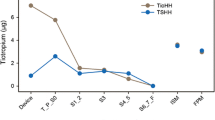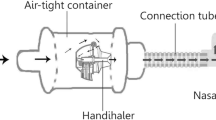Abstract
Purpose
To compare the pulmonary pharmacokinetics and relative bioavailability of salmon calcitonin delivered as aqueous droplets, pH 6.6 and pH 4.8 with that of a spray dried powder in healthy volunteers.
Methods
Spray dried powders (1.6 μm [GSD 2.1]) containing 5% by wt. sCal, 6.25% human serum albumin, 73.55% mannitol and 15% citric acid/sodium citrate were prepared using a Buchi model 190 spray drier. Aqueous solutions were prepared by dissolving the spray dried powder at a sCal concentration of 1.25 mg/ml, pH was adjusted using 21 mM sodium hydroxide. Aerosols were delivered as part of a 4 way cross-over study to 16 healthy volunteers. The Nektar pulmonary delivery device was used to deliver the dry powder aerosol. A Salter nebulizer controlled by a Rosenthal dosimeter was used to deliver the aqueous aerosols. Miacalcin™ injection was used as the subcutaneous control. Dose delivered to the lung was estimated by gamma scintigraphy. Plasma concentrations of sCal were measured using a radioimmunoassay.
Results
Aerosol size distributions were matched, 3.3 μm MMAD and ∼2.2 GSD. Inhaled flow rates were similar, although not equal, 5.8 and ∼9.8 l/min respectively for dry powder and liquid inhalations. Lung doses of sCal ranged from 53 to 88 μgm, peripheral lung doses from 25 to 51 μgm. Pharmacokinetic profiles and lung bioavailability relative to subcutaneous injection for all formulations were similar (not statistically significantly different p > 0.05), relative lung bioavailability ranged from 11% to 18%, estimates of relative bioavailability based on peripheral lung dose ranged from 20% to 33%.
Conclusion
The study showed no difference in pharmacokinetic profiles between the various aerosol dosage forms. pH of the aqueous solutions did not affect kinetics or relative bioavailability.



Similar content being viewed by others
Abbreviations
- ACI:
-
Andersen impactor
- AUC:
-
area under the curve
- BAV:
-
bioavailability
- C:
-
central
- DCU:
-
dose content uniformity
- GSD:
-
geometric standard deviation
- HPLC:
-
high pressure liquid chromatograph
- MMAD:
-
mass median aerodynamic diameter
- P:
-
peripheral
- P/C:
-
ratio, peripheral to central ratio
- PDS:
-
Nektar pulmonary delivery system
- PSD:
-
particle size distribution
- sCal:
-
salmon calcitonin
- SD:
-
standard deviation
- USP:
-
united States Pharmacopeia
- VMD:
-
volume median diameter
References
H. Folkesson, B. Westrom, and B. Karlsson. Permeability of the respiratory tract to different sized macromolecules after intratracheal instillation in young and adult rats. Acta Physiol. Scand 139:347–354 (1990).
R. Niven, F. Lott, A. Ip, and J. Cribbs. Pulmonary delivery of powders and solutions containing recombinant human granulocyte colony-stimulating factor (rhG-CSF) to the rabbit. Pharm. Res 11(8):1101–1109 (1994).
S. Kobayashi, S. Kondo, and K. Juni. Pulmonary delivery of salmon calcitonin dry powders containing absorption enhancers in rats. Pharm. Res 13(1):80–83 (1996).
S. Kobayashi, S. Kondo, and K. Juni. Study on pulmonary delivery of salmon calcitonin in rats: effects of protease inhibitors and absorption enhancers. Pharm. Res 11(9):1239–1243 (1994).
T. Morita, A. Yamamoto, Y. Takaura, M. Hashida, and H. Sezaki. Improvement of pulmonary absorption of (Asu 1,7)—eel calcitonin by various protease inhibitors in rats. Pharm. Res 11(6):909–913 (1994).
S. White, D. B. Bennett, S. Cheu, S. P. Conley, D. B. Guzek, S. Gray, J. Howard, R. Malcolmson, J. M. Parker, P. Roberts, N. Sadrzadeh, J. D. Schumacher, S. Seshadri, G. W. Sluggett, C. L. Stevenson, and N. J. Harper. Exubera: pharmaceutical development of a novel product for pulmonary delivery of insulin. Diabetes Technol. Ther 7:896–906 (2005).
J. Patton. Mechanisms of macromolecule absorption by the lungs. Adv. Drug Deliv. Rev 19:3–36 (1996).
J. D. Burr, J. M. Anthony, G. S. Axford, J. W. Etter, and A. E. Smith. Apparatus and methods for dispersing dry powder medicaments. US Patent 6(089):228 (2000).
A. R. Clark, C. B. Chambers, D. Muir, M. T. Newhouse, S. Paboojian, and C. Schuler. The effect of biphasic flow profiles on the deposition and clearance of coarse (6.5 mm) bolus aerosols. J. Aerosol. Med 20(1):75–82 (2007).
E. Berg, J. Svensson, and L. Asking. Determination of nebulizer droplet size distribution: A method based on impactor refrigeration. J. Aerosol. Med 20(2):97–104 (2007).
A. R. Clark. The use of laser diffraction for the evaluation of the aerosol clouds generated by medical nebulizers. Int. J. Pharm 115:69–78 (1995).
USP/NF, Physical tests and determinations: Aerosols, Vol 20 US XVII. US Pharmacopeia, Rockville, MD: US Pharmacopeial conventions, Inc. 1992, pp. 3158–3178
G. R. Pitcairn, and S. P. Newman. Radiolabelling of dry powder formulations. In R. N. Dalby, P. R. Byron, and S. J. Farr (eds.), Respiratory drug delivery VI, Interpharm Press, Buffalo Grove, 1998, pp. 397–399.
M. T. Newhouse, P. Hirst, S. Duddu, Y. Walter, T. Tarara, A. Clark, and J. Weers. Inhalation of a dry powder tobramycin Pulmosphere formulation in healthy volunteers. Chest 124:360–366 (2003).
S. P. Newman, A. R. Clark, N. Talaee, and S. W. Clarke. Pressurised aerosol deposition in the human lung with and without an “open” spacer. Thorax 44:706–710 (1989).
G. R. Pitcairn, and S. P. Newman. Tissue attenuation corrections in gamma scintigraphy. J. Aerosol. Med 10:187–198 (1997).
S. P. Newman, P. R. Hirst, G. R. Pitcairn, and A. R. Clark. Understanding regional lung deposition in gamma scintigraphy. In R. N. Dalby, P. R. Byron, and S. J. Farr (eds.), Respiratory Drug Delivery VI, Interpharm Press, Buffalo Grove, 1998, pp. 9–15.
F. Komada, S. Iwakawa, N. Yamamoto, H. Sakakibara, and K. Okumura. Intratracheal delivery of peptide and protein agents: absorption from solution and dry powder by rat lung. J. Pharm. Sci 83(6):863–867 (1994).
L. Heinemann, and T. Heise. Current status of the development of inhaled insulin. Br. J. Diab. Vac. Dis 4(5):295–301 (2004).
K. Okumura, S. Iwaka, Y. Tsuguchika, S. Toshimitsu, and F. Komada. Intratracheal delivery of insulin absorption from solution an aerosol by rat. Int. J. Pharm 88:63–73 (1992).
S. J. Farr, I. Gonda, and V. Licko. Physicochemical and physiological factors influence the effectiveness of inhaled insulin. In R. N. Dalby, P. R. Byron, and S. J. Farr (eds.), Respiratory Drug Delivery VI, Interpharm Press, Buffalo Grove, 1998, pp. 25–33.
J. S. Patton, J. G. Bukar, and M. A. Eldon. Clinical pharmacokinetics and pharmacokinetics of inhaled insulin. Clin. Pharmacokinet 43(12):781–801 (2004).
Author information
Authors and Affiliations
Corresponding author
Rights and permissions
About this article
Cite this article
Clark, A., Kuo, Mc., Newman, S. et al. A Comparison of the Pulmonary Bioavailability of Powder and Liquid Aerosol Formulations of Salmon Calcitonin. Pharm Res 25, 1583–1590 (2008). https://doi.org/10.1007/s11095-008-9547-x
Received:
Accepted:
Published:
Issue Date:
DOI: https://doi.org/10.1007/s11095-008-9547-x




